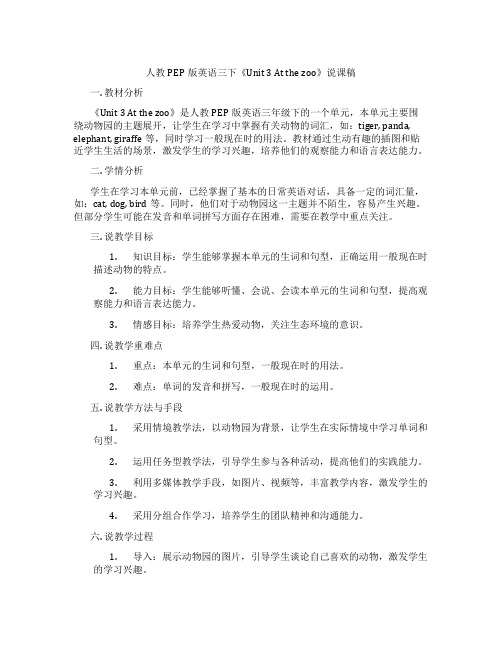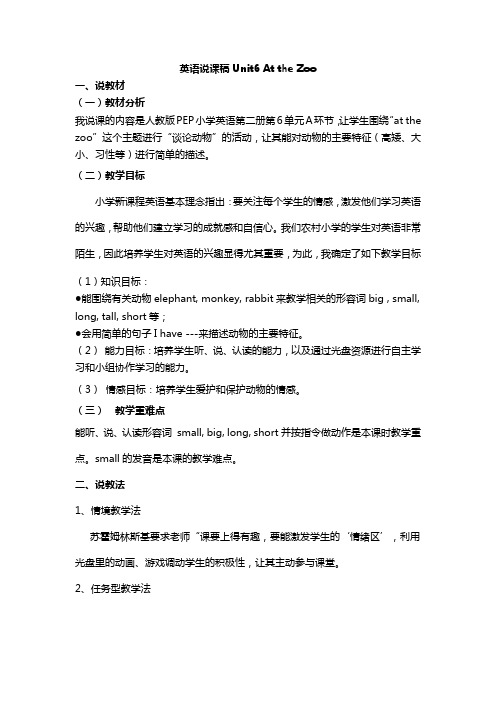at the zoo说课稿
- 格式:doc
- 大小:34.00 KB
- 文档页数:2

Good morning, ladies and gentlemen. My name is Zhang Jiao. I come from the Experimental Primary School. I’m glad to be here (to share my lesson) with you. Now, I will show the lesson from the following 7 parts.First, let’s focus on teaching content.The lesson is the first session of Part B----Let’s learn & Let’s do, of Unit 3---At the zoo of PEP Primary English, Book 3B.Second, I set the following aims.①The first one is language knowledge.By the end of the lesson, students can read, recognize, and speak key words and sentences.②The second one is language skills.Students can talk about animals and understand the sentences from others.Students can understand and act out the part---“Let’s do”The third one is emotional aim.By the end of the lesson, students can love and protect the animals more. Third, Let’s make clear the key and difficult points.The key points are words:tall, short, big, small.The difficult ponits is that students can use the sentence “It has...”The fourth part is about my preparation.I prepare several dolls and a PPT.The fifth part is about teaching& learning methods.Based on the recognization feature of the students, I choose to use the methods like, “show and tell” ,“ Playing Cartoons” to interst them. Step by step, motivate them to learn actively.The six part is the main one---Teaching Procedure.Step 1. Warm-up.Greetings. Teaher and the students say hello to each other.[Greetings is designed to draw the attention of students to the class quickly (more than just to show politeness)]Step 2. Lead-in.1.Play <Pink Panther> and the teacher explain.[Cartoon can easily catch the eyeballs of the students in lower-grades.]2.Show the doll “pink panther”. The cartoon image jumps out into the class. The teacher uses the dolls voice to talk with her students.[Make the students exciting and curious about the new lesson.]Step 3. New Knowledge & Practice.1A. From the main features(特征) of “pink panther”, like (如)“long arms, long legs, long tail”, we get the new word“long” together. Then we call its best friend “rabbit”. In the same way, we talk about its main features, like “short arms, short legs and short tail” and get another new word--- “short”.[Use the “show and tell” method to make the students take notice of the two words directly.]1B. Read the two new words on the blackboard by lines and rows.[Practice the first pair of new word timely(及时).]2A. Then we continue to compare the two dolls. “Panther is big”& “Rabbit is small”. Again, from their different features we get another group of antonyms(此词是“反义词”或换为words从简)----Big & small.2B. Students compete to read more times of “big & small”in one breath to practice them timely. Or other ways like reading in rising and falling tones(升降调).Step 4. Consolidation./Reinforcement (巩固)A Guessing Game.① First,by reading pictures of the body parts and the reminding words(提示话语),make a guess of the animal.[For a new learner, the pictures and words help a lot in guessing. Students can consolidate/reinforce the new words at the same time.]② Then, guess the animal only by reminding words.[Through the first round, students has been familiar with the phrases like, small eyes, big eyes, a long nose. Besides, they has already input(输入,或改为practice)the key sen tence “It has...”repeatedly(或again and again或in large amount)]③Third round(第三轮): Led by the teacher, students retell the reminding words(谜语直译该是riddle,但我猜,这里复述的是不是还是前面的提示话语) by the help of the outlines(提纲,多个).[The three rounds actually go forward one by one in learning. By the third round, students can use new words and sentences to do such a comprehensive guessing game.]Learn and practice the part “Let’s do”1.RestHave a rest and listen to Part “Let’s do” and enjoy the cartoons.[Make the students rest for a while after the stressful new knowledge learning. Meanwhile/At the same time/What’s more, get ready for the learning of this part.] 2.Learn and practice by groupsListen to “Let’s do”and try to tap the beat. Humming(哼唱,或sing) in a low voice to the beat. Practice and then show by groups.[Beat can interest the students. By groups, students teach each other and learn group working.]Create a situation in zooPractice the new words and sentences in the situation. Mainly make the students speak out the feature of an ostrich. Lead them to form 4 sentences. First one will be given by the teacher as a model. The following three will be left to the students under the leading of the teacher. They can form part of the sentence first and then the whole. [Practice their ability of application锻炼运用能力.]Step 5. TestA multiple-choice question about the features of Tom and Jerry.[Test the new words simply and clearly]Step 6. Extending and emotional education.The idea of loving the animal goes through all the teaching steps. The teacher put an end to the class by a proverb to bring out the idea.The seventh part is the blackboard design.具体板书:[具体是什么样的展示?Match the things with the words. Show the new knowledge more clear and direct.]。

英语活动教案《At the zoo》教案英语一、教学内容本节课选自教材《英语乐园》第三册第四章《At the zoo》,详细内容包括:词汇(如大象、长颈鹿、狮子等),句型(如What's this? It's a;I like等),以及简单的描述动物特征的形容词(如big, tall, strong等)。
二、教学目标1. 让学生掌握与动物园相关的词汇及句型,能进行简单的情景对话。
2. 培养学生用英语描述动物特征的能力,提高他们的英语表达能力。
3. 激发学生对动物的热爱,培养他们的环保意识。
三、教学难点与重点1. 教学难点:形容词的运用,描述动物特征的句型。
2. 教学重点:词汇、句型的掌握,以及简单的情景对话。
四、教具与学具准备1. 教具:PPT,动物卡片,词汇卡片,录音机,磁带。
2. 学具:学生用书,练习册,彩色笔。
五、教学过程1. 导入:通过展示一张动物园的图片,引导学生用英语描述他们看到的动物,激活学生的背景知识。
2. 呈现:呈现词汇卡片,教授新单词,让学生跟读并模仿。
然后通过PPT展示句型,引导学生进行情景对话。
3. 练习:分组进行角色扮演,练习词汇和句型。
同时,进行随堂练习,巩固所学知识。
4. 应用:让学生用所学词汇和句型,描述自己喜欢的动物,并进行小组分享。
六、板书设计1. At the zoo2. 词汇:elephant, giraffe, lion, tiger, bear, monkey等。
3. 句型:What's this? It's a;I like;It's4. 形容词:big, tall, strong, cute, funny等。
七、作业设计1. 作业题目:(1)用所学词汇和句型,写一篇关于你最喜欢的动物的短文。
(2)制作一张动物园的手抄报,用英语标注各种动物和它们的特征。
2. 答案:见附件。
八、课后反思及拓展延伸1. 反思:关注学生在课堂上的表现,了解他们在学习过程中遇到的困难,及时调整教学方法,提高教学效果。


人教PEP版英语三下《Unit 3 At the zoo》说课稿一. 教材分析《Unit 3 At the zoo》是人教PEP版英语三年级下的一个单元,本单元主要围绕动物园的主题展开,让学生在学习中掌握有关动物的词汇,如:tiger, panda, elephant, giraffe等,同时学习一般现在时的用法。
教材通过生动有趣的插图和贴近学生生活的场景,激发学生的学习兴趣,培养他们的观察能力和语言表达能力。
二. 学情分析学生在学习本单元前,已经掌握了基本的日常英语对话,具备一定的词汇量,如:cat, dog, bird等。
同时,他们对于动物园这一主题并不陌生,容易产生兴趣。
但部分学生可能在发音和单词拼写方面存在困难,需要在教学中重点关注。
三. 说教学目标1.知识目标:学生能够掌握本单元的生词和句型,正确运用一般现在时描述动物的特点。
2.能力目标:学生能够听懂、会说、会读本单元的生词和句型,提高观察能力和语言表达能力。
3.情感目标:培养学生热爱动物,关注生态环境的意识。
四. 说教学重难点1.重点:本单元的生词和句型,一般现在时的用法。
2.难点:单词的发音和拼写,一般现在时的运用。
五. 说教学方法与手段1.采用情境教学法,以动物园为背景,让学生在实际情境中学习单词和句型。
2.运用任务型教学法,引导学生参与各种活动,提高他们的实践能力。
3.利用多媒体教学手段,如图片、视频等,丰富教学内容,激发学生的学习兴趣。
4.采用分组合作学习,培养学生的团队精神和沟通能力。
六. 说教学过程1.导入:展示动物园的图片,引导学生谈论自己喜欢的动物,激发学生的学习兴趣。
2.新课呈现:通过展示动物园的动物图片,引导学生学习本单元的生词,如:tiger, panda等。
3.句型练习:运用一般现在时,让学生描述动物的特点,如:The tigeris big.4.小组活动:学生分组讨论,运用所学单词和句型介绍自己组的动物。
5.听力练习:播放听力材料,学生听后回答问题。

小学英语《At the zoo》说课稿Good afternoon, dear judges. I’m No.8. Today my topic is “At the zoo”. It’s my honor to present my teaching design with you. And I know , a good lesson needs a great design. I have been ready to begin this presentation with five aspects:1. The teaching materials2. The students3. The teaching and learning methods4. The teaching procedure5. The blackboard designAt the beginning, I will introduce the materials. This lesson is from Unit 2,primary English book 2, Hebei Education Press . This content is about the animals of zoo.And it’s important for students to learn about it in a daily life . So I’ll set many activities and games to help students obtain four skills,such as listening,speaking, reading, and writing. It follows that this lesson is an important position of the materials.According to the new curriculum standard, the teaching aims are as follows:1.The knowledge and the ability aim: to enable the studentsto master the new words, like zoo,panda,monkey, elephant,big,small and the new sentences:The elephant is big.The bird is small.The panda is fat.The monkey is thin....and so on. But the most important thing is to teach them how to use in the real situation.2.The process and the method aim: to arouse their interests in learning English. And to help the students foster the ability of communicating with others.3.The moral aim: to foster S s ’ consciousness of good-cooperation and proper competition .And then ,I’ll make my teaching key point and difficult point as follows: the key point includes the new words and sentences, such as zoo,panda,monkey, elephant,big,small and the new sentences:The elephant is big.The bird is small.The panda is fat.The monkey is thin.And the difficult point is to teach them how to use it with others.And also,I should to take care the students.Because they are active, competitive, and they are curious about everything. Obviously, students in Grade 3 have issues in learning English. It requires teachers to use attractive teaching method. So for the teac hing method, I’ll mainly use communicative method and seeing-hearing method to teach this lesson.At the same time ,tolead the students use cooperative inquiry method.The next is teaching procedure. It includes the following steps.Step 1. Warming upFor this step,I can speak a tongue twister.like this,Rain, rain,go away.This is mother’s washing day . Come again another day . We can waving have a happy date .After speaking a tongue twister some times together,it can mobilizing classroom atmosphere.Step 2. Lead inI’ll show some pictures about this lesson. And ask students:“Do you want to know the names about these pictures?” through this step,I will lead in the new words:zoo and so on.Step 3. PresentationI will point to a picture of zoo to ask students: “Where is this ?,what’s this?” students maybe point to the zoo and speak e the same method to teach other words ,such as panda,monkey and so on.After showing the new words,let students read one by one. Next I will ask S’s to read the new sentences.( The elephant is big. The bird is small. The panda is fat. The monkey is thin.)In the end,I will ask“What’s this?Big or small? F at or thin?”when I will point pictures of panda,monkey and so on.Through this step ,I will enable the students to know some new words and sentences.Step 4. PracticeA preliminary初步的 understanding,students need to train new knowledge. Firstly, divide the students into four groups and to train new sentences . Secondly ,we will have a competition. The fastest group to make up the sentences when I show the picture will get 5 scores. And I will give a gift to the champion.The reason that I do these activities is to draw the whole S s’ attention to spelling of the new words and consolidate the sentence pattern.Step5.SummaryThe whole class will review the all important words and sentences ,Such as new words,zoo,panda,monkey, elephant,big,small,and new sentences “The elephant is big.The bird is small.The panda is fat.The monkey is thin.”and so on.Step 6. TaskLet students communicate with parents and friends by using new words and sentences.Finally, I’ll talk about my blackboard design.Good blackboard design is the pocket edition. The title of this lesson is on the top of the blackboard.Divide the rest of blackboard into three parts. The left is for the key words,the middle is the main structures,while the right is for the scores of every group.OK , that’s all my teaching design. Thanks for your attention.。

英语说课稿Unit6 At the Zoo一、说教材(一)教材分析我说课的内容是人教版PEP小学英语第二册第6单元A环节,让学生围绕“at the zoo”这个主题进行“谈论动物”的活动,让其能对动物的主要特征(高矮、大小、习性等)进行简单的描述。
(二)教学目标小学新课程英语基本理念指出:要关注每个学生的情感,激发他们学习英语的兴趣,帮助他们建立学习的成就感和自信心。
我们农村小学的学生对英语非常陌生,因此培养学生对英语的兴趣显得尤其重要,为此,我确定了如下教学目标(1)知识目标:●能围绕有关动物elephant, monkey, rabbit来教学相关的形容词big , small, long, tall, short等;●会用简单的句子I have ---来描述动物的主要特征。
(2)能力目标:培养学生听、说、认读的能力,以及通过光盘资源进行自主学习和小组协作学习的能力。
(3)情感目标:培养学生爱护和保护动物的情感。
(三)教学重难点能听、说、认读形容词small, big, long, short并按指令做动作是本课时教学重点。
small的发音是本课的教学难点。
二、说教法1、情境教学法苏霍姆林斯基要求老师“课要上得有趣,要能激发学生的‘情绪区’,利用光盘里的动画、游戏调动学生的积极性,让其主动参与课堂。
2、任务型教学法在教学活动中,围绕形容词教学,设计任务,学生通过表达、沟通等形式来完成任务,以达到学习和掌握语言的目的。
3、“TPR”教学法采用“TPR”教学法让孩子通过找朋友、听指令等游戏调动孩子的多种感官活跃课堂气氛。
三、说学法1、合作学习在教学中我把班级同学分成6个小组,所有的教学活动都在小组中进行,同学与同学可以互动,体现了尊重个体差异的特点。
2、表演练习语言技能包括听、说、读、写四个方面的技能以及这四种技能的综合运用能力。
说是表达的技能,它包括玩演,能用英语做游戏有利于促进学生语言运用能力的提高。
Unit 6 At the zooUnit 6 At the zoo说课稿我说课的课题是第六单元《at the zoo》,我按以下五个程序说课:教学分析、教学目标、教学策略、教学过程、教学反思。
一、教学分析(一)分析教材:重大版小学英语四年级上册第一单元《at the zoo》,本教材特点与生活实际相结合,以学生交际功能为主要线路,兼顾语言结构,逐步引导学生运用英语完成有实际目的的语言任务。
(二)学情分析:四年级的小朋友已经学了一年的英语,但英语功底也很薄弱,我根据学生情况,以学生为主体,以激活他们对英语的兴趣为着入点。
《at the zoo》这一课围绕几只小动物展开对单词的认知,因为学生的年龄特点对动物也都很偏爱,所以我把本课运用我们多样化教学手段使学生轻松掌握重难点。
结合新课程标准及英语课程的总体目标我将教学目标及重难点设计如下.二、教学目标知识与技能:学习认读单词panda,.tiger,zebra,lion,elephant,学会句子Can you see…?过程与方法:通过课件,图片表格,动物头饰,和游戏达到对单词的认读掌握。
通过let’s do 这部分使学生学会单词的基础上完善语言结构。
情感目标:学习小动物名称的同时,教育孩子们要珍爱小动物因为动物是人类最好的朋友。
教学重难点:学会单词panda,.tiger,zebra,lion,elephant,并学会使用句型。
三、教学策略为了有效的达成教学目标,突出重点,突破难点,我采取了以下教学策略:(一)发挥信息技术优势借助信息技术强大的功能和优势,拓宽了学生的知识面。
(二)提高学生的能动性围绕新课标指出以学生为主体的思想,在课堂上教师要肯放手,提高学生的能动性,让学生成为课堂的主载者。
(三)兴趣激励在我们鼓励性语言评价中树立学生的自信心,有兴趣去说英语,做游戏及积极参与合作。
四、教学过程(一)激活思维,调动情感T:Greeting,helllo!hi,how are you? What’s your name?What’s this? This is---.Where is your hand/leg/arm? Here it is.May I have a look? Sure,Here you are.(设计意图:问候语不仅仅是考验孩子们的语言组织能力,更是我们教师与学生见面后最好的沟通方式),出示动物园的图片(设计意图:学生看到动物园的小动物,很自然的把学生带入我们的主题当中)。
《At the Zoo》说课稿各位老师:上午好!今天我说课的内容是《At the Zoo》第一课时。
一、教材分析本课内容出自三年级下册第三单元《At the Zoo》,主题是动物,是上册谈论动物的延续,也是用形容词描述动物特征的基础。
包括Let’s learn和Let’s do两部分,主要教学四个形容词thin, fat, tall, short 。
同时根据本单元的实际情况我也对Let’s talk部分的重点句型做了适当的渗透。
二、教学目标本节课的语言技能和知识目标是能听、说、认读四个单词并且能够在实际情境中运用句型Look at that..It’s so..描述动物。
情感态度目标是树立热爱动物、保护动物的思想感情。
学习策略目标是通过依旧带新,欣赏动物图片引出本节课的词汇,把词汇融入句型进行操练。
文化意识目标是树立主动交流,大胆开口的英语学习态度,在活动激发学生学习英语的兴趣。
三、教学重、难点本课时教学重点是能听、说、认读几个形容词thin, fat, tall, short 以及实际运用。
教学难点是在学习单词的基础上灵活运用新句型“Look at that…”It’s so…”。
四、说学法通过用旧知识引入本课新知识的方法,让学生主动参与到学习中去。
引导学生观察、思考,不仅掌握本节课的内容,还由此发展学生各方面的能力。
五、说教法结合教材和学生的身心特点,在本课时的教学设计中,我从学生的兴趣和认知水平出发,利用有趣的图片吸引学生的注意力。
让学生在愉快中学习,激发学生学习英语的兴趣,帮助他们建立学习的成就感和自信心。
六、教学过程为落实本课目标,我设计了以下教学环节:Warm-up、Pressentation、Practice 、Consoliation 、Summary 、Homework。
1、复习热身在热身的时候,我主要设计了Free talk通过师生互动,复习动物的名称,然后听唱歌曲“They are in the zoo”吸引学生的兴趣,同时也为本节课创设主题情景。
atthezoo说课稿UNIT6 《At the Zoo》说课稿一、说教材1.教学内容与分析我说课的内容是人教版三年级下册Unit 6“At the Zoo”A部分第二课时。
包括Part A"Let’s learn”和“Let's do"。
本节课主要利用小动物的单词引出并活学活用单词small, big, long short.通过各种活动,调动学生积极性。
让学生能够灵活运用所学单词,并用到句子中去。
2.学情分析学生是在学习过动物的基础上来学习本课的,他们已有一定的英语基础。
在教学中要尽量充分设计生活情景,调动学生的情绪,让他们学会在实际情境中利用所学短语.3.教学目标根据学生实际和教材特点,我将本课的教学目标拟定为:知识目标:本部分主要呈现几个形容词:small, big, long short.要求学生能够听说认读,并练习Let's do。
能力目标:让学生能够运用所学的单词。
情感目标:培养学生热爱自然,热爱动物的习惯。
4.教学重、难点要求学生听、说、认、读单词small, big, long short,并学生能够灵活运用所学单词。
5.课前准备教师:录音机、磁带、单词卡和图片。
二、说教法和学法1、循序渐进原则,本节课的重点是单词的学习,并让学生能够在实际情景中运用所学单词。
我在教学中将这个目标进行分解。
先进行重点单词的操练,从易到难。
在此基础上学习运用单词就轻松多了。
2、生活化原则,学习是为了应用,在本课的练习中,鼓励学生用所学单词运用到具体生活语境中。
3、运用多媒体教学,运用多种游戏激趣,操练单词。
4、学生是说中学,多说多练,并联系身边的人和事进行交流和实际运用。
三、说教学过程(一)、Warm-up1、日常口语练习2、TPR3、建立小组评比(二)、Presenation课件快速闪过giraffe,让学生猜,最后边说边板书giraffe,出示单词卡,叫学生认读giraffe并书空拼读。
人教PEP版英语三年级下册Unit 3《At the zoo》说课稿一. 教材分析《人教PEP版英语三年级下册Unit 3 At the zoo》讲述了关于动物的认知和描述。
通过本节课的学习,学生能够掌握动物的名称以及描述它们的外貌特征和动作。
教材通过生动的插图和简单实用的句子,激发学生的学习兴趣,培养他们的观察力和想象力。
二. 学情分析针对三年级的学生,他们已经具备了一定的英语基础,对动物有一定的认知。
但在口语表达和听力理解方面还有待提高。
因此,在教学过程中,要关注学生的个体差异,充分调动他们的积极性,鼓励他们大胆开口说英语。
三. 说教学目标1.知识目标:学生能够听懂、会说、会读本节课所学的动物名称和描述动物的词汇。
2.能力目标:学生能够用英语简单描述动物的外貌特征和动作。
3.情感目标:通过本节课的学习,学生能够培养对动物的喜爱之情,提高保护动物的意识。
四. 说教学重难点1.重点:动物名称和描述动物的词汇。
2.难点:如何运用所学词汇和句型正确描述动物。
五. 说教学方法与手段1.采用情境教学法,通过设置动物园的场景,让学生在真实的环境中学习动物的名称和描述。
2.运用任务型教学法,引导学生通过完成各种任务,提高口语表达和听力理解能力。
3.利用多媒体教学手段,如图片、视频等,丰富教学内容,激发学生的学习兴趣。
六. 说教学过程1.导入:通过播放动物的歌曲,引导学生谈论自己喜欢的动物,激发学生的学习兴趣。
2.新课呈现:展示动物园的场景,引导学生学习动物的名称和描述词汇。
3.操练环节:通过各种游戏和活动,让学生在实际操作中运用所学知识。
4.小组活动:学生分组进行角色扮演,模拟在动物园的场景,运用所学词汇和句型进行交流。
5.巩固环节:通过听力练习和口语表达,检验学生对所学知识的掌握程度。
6.总结:对本节课所学内容进行总结,强调重点词汇和句型。
七. 说板书设计板书设计要简洁明了,突出本节课的重点词汇和句型。
可以设计成动物园的场景,将动物名称和描述词汇以图片和文字的形式呈现出来。
冀教版小学英语三年级下册Lesson7 At the Zoo
说课稿
路志高
一、说教材
1.教学内容与分析
我说课的内容是冀教版三年级下册Lesson7“At the Zoo”A部分第二课时。
包括三部分。
本节课主要利用小动物的单词引出并活学活用单词
small, big, long short.通过各种活动,调动学生积极性。
让学生能够灵活运用所学单词,并用到句子中去。
2.学情分析
学生是在学习过动物的基础上来学习本课的,他们已有一定的英语基础。
在教学中要尽量充分设计生活情景,调动学生的情绪,让他们学会在实际情境中利用所学短语.
3.教学目标
根据学生实际和教材特点,我将本课的教学目标拟定为:
知识目标:本部分主要呈现三个动物单词四个形容词:small, big, long short.要求学生能够听说认读,并练习造句型
能力目标:让学生能够运用所学的单词。
情感目标:培养学生热爱自然,热爱动物的习惯。
4.教学重、难点
要求学生听、说、认、读单词small, big, long short,并学生能够灵活运用所学单词。
5.课前准备
教师:课件录音机、磁带、单词卡和图片。
二、说教法和学法
1、循序渐进原则,本节课的重点是单词的学习,并让学生能够在实际情景中运用所学单词。
我在教学中将这个目标进行分解。
先进行重点单词的操练,从易到难。
在此基础上学习运用单词就轻松多了。
2、生活化原则,学习是为了应用,在本课的练习中,鼓励学生用所学单词
运用到具体生活语境中。
3、运用多媒体教学,运用多种游戏激趣,操练单词。
4、学生是说中学,多说多练,并联系身边的人和事进行交流和实际运用。
三、说教学过程
(一)、Warm-up
1、日常口语练习;唱歌曲
2、猜动物游戏。
T: Listen to me , children. Guess what it is.
It has a long nose. It has big ears and a long tail.
P: It’s an elephant.
T: Yes , it is.
3、学生四人一组,表演A部分Let's talk对话。
【设计意图】:与学生进行日常会话,进行热身.并引入情景.
(二)、Presenation
我拿出事先准备的老鼠图片,对学生说,
Look at the mouse. Is it big or small? 学生答small. 教师说Yes, it’s small. 边说边板书small.
出示单词卡,叫学生认读small.并书空拼读。
同样,可以出示一张大象的图片,介绍The elephant is big.然后出示单词卡,叫学生认读big.并书空拼读。
接着,我同法教授单词short long。
之后我让学生听录音,用手指着单词,跟读Let’s learn部分的词汇。
【设计意图】:达到师生互动教学。
(三)、Practice
请发音标准的学生把Let's learn部分的单词卡举起,带读,学生以“开火车”“听音传球”的游戏形式练习.,还可以让学生试着拼读单词。
例如:
S-M-A-L-L---small;B-I-G---big,力求将每个字母读得清楚.准确。
接着我让学生听录音,边说边做Let’sdo部分的内容。
做动作是要尽量夸张,以提高学生的兴趣。
【设计意图】:通过游戏,即激发了学生的学习兴趣,又使学生在宽松的情景下巩固复习了所学的知识。
(四)、Home work
让学生总结一下本节课所学的内容之后,给学生留点作业。
就是听录音,仿读会话,并在实际情景中运用会话。
四、说板书设计
Lesson7 “At the Zoo”
small
bi g
short
long
本课的板书设计简单明了,就是两组反义词。
五、说课后反思:
本节课学生基本掌握了单词small, big, long short。
学生通过Let's do 加强了对单词的掌握程度。
另外,作为英语教师的我们应该注意在小学的低年级阶段,要培养对学生的亲近感。
在课堂教学中英语教师要十分尊重学生,注意激励学生,关注学生学习过程。
在当前“减负”工作中,英语教师尤其要注意体察学生在课堂上的心理感受,亲近学生,使学生喜爱英语教师和英语课,从而提高英语课堂教学的效益。